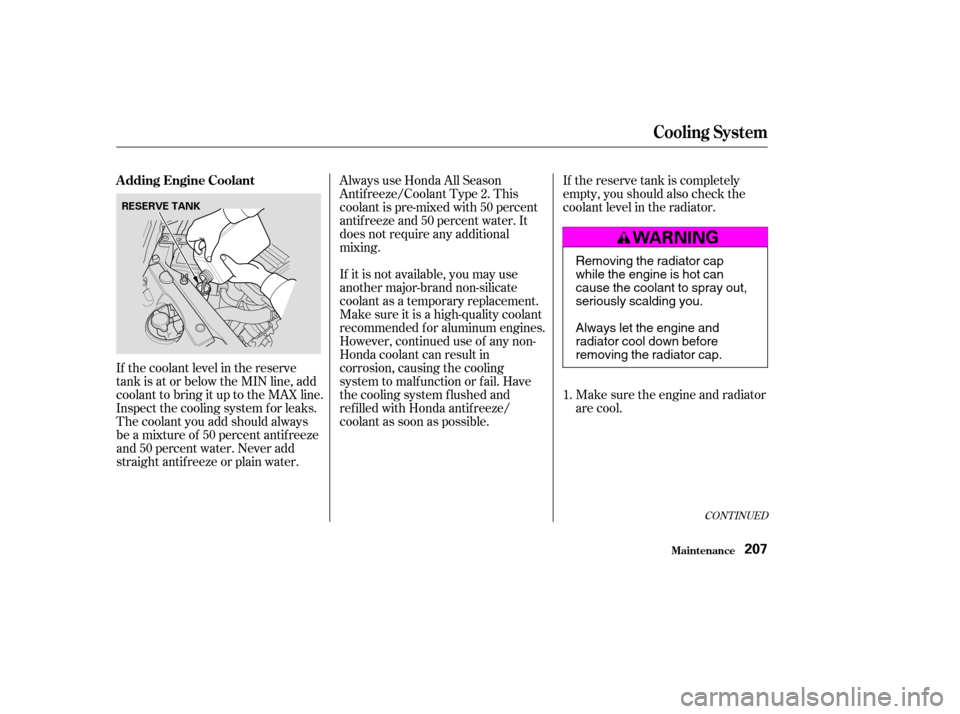Page 54 of 302
These labels are in the locations
shown. They warn you of potential
hazards that could cause serious
injury. Read these labels caref ully.
If a label comes of f or becomes hard
to read, contact your Honda dealer
f or a replacement.U.S. modelsCanadian models
U.S. models only
Saf ety L abels
Driver and Passenger Saf ety56
RADIATOR CAP SUN VISOR
DASHBOARD
�����—�����—�����y�
����
��������y���
�(���%�������y���������y
Page 156 of 302
Remove the dipstick again and
check the level. It should be
between the upper and lower
marks.Look at the coolant level in the
radiator reserve tank. Make sure it is
between the MAX and MIN lines. If
it is below the MIN line, see
on page f or
inf ormation on adding the proper
coolant.
If it is near or below the lower mark,
see on page . Refer to
on page f or inf ormation
on checking other items in your
Honda.
4. 203 207201
A dding
Engine Coolant
A dding Oil Owner Maintenance
Checks
Engine Coolant Check
Service Station Procedures
Bef ore Driving161
UPPER MARK
LOWER MARK MAX
MIN
�����—�����—�����y�
�������������y���
�(���%�������y���
�����y
Page 194 of 302

�µ�µ�µ �µ
�µ
�µ
�µ
Engine oil level Check every
time you fill the fuel tank. See
page .
Engine coolant level Check the
radiator reserve tank every time
you f ill the f uel tank. See page .
Windshield washer f luid Check
the level in the reservoir monthly.
If weather conditions cause you to
use the washers f requently, check
the reservoir each time you stop
f or f uel. See page .
Youshouldcheckthefollowing
items at the specif ied intervals. If
you are unsure of how to perf orm
any check, turn to the page given.
Lights Check the operation of
the headlights, parking lights,
taillights, high-mount brake light,
turn signals, brake lights, and
license plate lights monthly. See
page .
Tires Check the tire pressure
monthly. Examine the tread f or
wear and foreign objects. See page
.
Automatic transmission Check
the f luid level monthly. See page .
Brakes Check the f luid level
monthly. See page . 160
161
213
214 217 232
239
Owner Maintenance Checks
Maint enance201
�����—�����—�����y�
�������������y���
�(���%�������y���������y
Page 195 of 302
Fluid Locations
Maint enance202
ENGINE OIL
FILL CAPBRAKE FLUID
(Gray cap)
CLUTCH FLUID
(Gray cap)
WASHER FLUID
(Blue cap)
POWER STEERING
FLUID (Red cap)
AUTOMATIC
TRANSMISSION FLUID
DIPSTICK (CVT)
(Yellow loop)
RADIATOR CAP
ENGINE
COOLANT
RESERVOIR ENGINE OIL DIPSTICK
(Orange loop)
AUTOMATIC
TRANSMISSION
FLUID DIPSTICK
(Yellow loop)
�����—�����—�����y�
���������
���y���
�(���%�������y���������y
Page 200 of 302

If the coolant level in the reserve
tank is at or below the MIN line, add
coolant to bring it up to the MAX line.
Inspect the cooling system f or leaks.
The coolant you add should always
be a mixture of 50 percent antif reeze
and 50 percent water. Never add
straight antif reeze or plain water.If the reserve tank is completely
empty, you should also check the
coolant level in the radiator.
Make sure the engine and radiator
are cool.
Always use Honda All Season
Antif reeze/Coolant Type 2. This
coolant is pre-mixed with 50 percent
antif reeze and 50 percent water. It
does not require any additional
mixing.
If it is not available, you may use
another major-brand non-silicate
coolant as a temporary replacement.
Make sure it is a high-quality coolant
recommended f or aluminum engines.
However, continued use of any non-
Honda coolant can result in
corrosion, causing the cooling
system to malf unction or f ail. Have
the cooling system f lushed and
ref illed with Honda antif reeze/
coolant as soon as possible.
1.
CONT INUED
A dding Engine Coolant
Cooling Syst em
Maint enance207
RESERVE TANK
Removing the radiator cap
while the engine is hot can
cause the coolant to spray out,
seriously scalding you.
Always let the engine and
radiator cool down before
removing the radiator cap.
�����—�����—�����y�
�����������
�y���
�(���%�������y�����
���y
Page 201 of 302
Remove the radiator cap by
pushing down and turning
counterclockwise.
Turn the radiator cap counter-
clockwise, without pressing down
on it, until it stops. This relieves
any pressure remaining in the
cooling system.
The coolant level should be up to
the base of the f iller neck. Add
coolant if it is low.Do not add any rust inhibitors or
other additives to your car’s cooling
system. They may not be compatible
with the coolant or engine compo-
nents.
Pour coolant into the reserve tank.
Fill it to half way between the MAX
and MIN marks. Put the cap back
on the reserve tank.
Put the radiator cap back on.
Tighten it f ully.
Pourthecoolantslowlyand
caref ully so you do not spill. Clean
up any spills immediately. Spilled
coolant could damage components
in the engine compartment.
2. 3.
4. 5.6.
Cooling Syst em
Maint enance208
RESERVE TANK
RADIATOR CAP
�����—�����—�����y�
���������
�
�y���
�(���%�������y�����
�
�y
Page 202 of 302
CONT INUED
Remove the radiator cap.
Turn the ignition ON (II). Turn
the temperature control dial to
maximum heat. Turn of f the
ignition. Open the hood. Make
sure the engine and radiator are
cool to the touch.
Draining the coolant requires access
to the underside of the car. Unless
you have the tools and knowledge,
you should have this maintenance
done by a skilled mechanic.
Thecoolingsystemshouldbe
completely drained and ref illed with
new coolant according to the time
and distance recommendations in
the maintenance schedule. Only use
Honda All Season Antif reeze/
Coolant Type 2.
Loosen the drain plug on the
bottom of the radiator. The
coolant will drain through the
splash guard. Remove the drain
bolt and washer f rom the engine
block. Drain the coolant into an
appropriate container.
1.
3.
2.
Replacing Engine Coolant
Cooling Syst em
Maint enance209
DRAIN BOLT
DRAIN
PLUG
�����—�����—�����y�
�������������y���
�(���%�������y�����
���y
Page 204 of 302
Tightening torque:
When the coolant stops draining,
tightenthedrainpluginthe
bottom of the radiator. Apply non-
hardening sealant to the drain bolt
threads, put a new washer on the
drain bolt, and reinstall the drain
bolt in the engine block. Tighten it
securely.
Pour Honda All Season
Antif reeze/Coolant Type 2 into
the radiator up to the base of the
f iller neck. This coolant is a
mixture of 50 percent antif reeze
and 50 percent water. Pre-mixing
is not required.The cooling system capacity is:
10.
11.
CONT INUED
With 5-speed manual transmission:With automatic transmission:With automatic transmission (CVT):
Cooling Syst em
Maint enance211
Fill up to here
FILLER NECK
58 lbf·ft (78 N·m , 8.0 kgf·m)
1.03 US gal (3.9
)
1.00 US gal (3.8
)
1.00 US gal (3.8
)
�����—�����—�����y�
�������������y���
�(���%�������y�����
���y